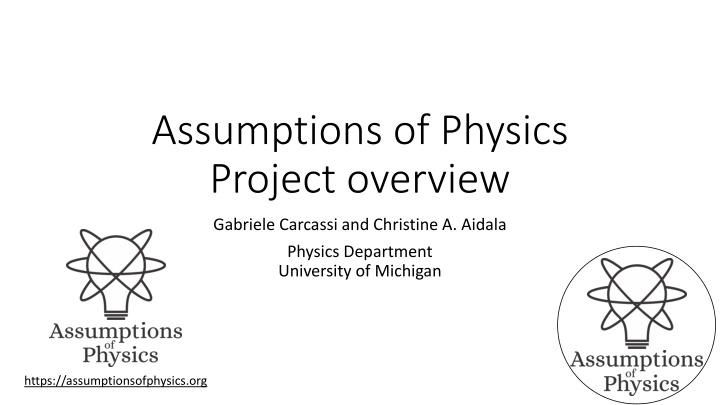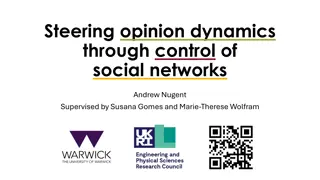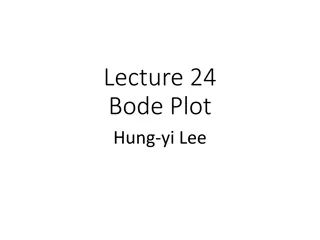
Foundations of Physics: Exploring Physical Reality and Mathematical Frameworks
Delve into the Assumptions of Physics project, spearheaded by Gabriele Carcassi and Christine A. Aidala from the University of Michigan. This project aims to derive basic laws rigorously from physical starting points, considering the intersection of empirical and metaphysical realities, philosophy of science, and the requirements of physical theories. Explore the quest for an ultimate theory, different approaches to foundational physics, and the role of observers in shaping our understanding of the universe.
Download Presentation

Please find below an Image/Link to download the presentation.
The content on the website is provided AS IS for your information and personal use only. It may not be sold, licensed, or shared on other websites without obtaining consent from the author. If you encounter any issues during the download, it is possible that the publisher has removed the file from their server.
You are allowed to download the files provided on this website for personal or commercial use, subject to the condition that they are used lawfully. All files are the property of their respective owners.
The content on the website is provided AS IS for your information and personal use only. It may not be sold, licensed, or shared on other websites without obtaining consent from the author.
E N D
Presentation Transcript
Assumptions of Physics Project overview Gabriele Carcassi and Christine A. Aidala Physics Department University of Michigan https://assumptionsofphysics.org
Main goal of the project Identify a handful of physical starting points from which the basic laws can be rigorously derived For example: Irreducibility Quantum state Infinitesimal reducibility Classical state https://assumptionsofphysics.org ? time time This also requires rederiving all mathematical structures from physical requirements For example: Science is evidence based scientific theory must be characterized by experimentally verifiable statements topology and ?-algebras https://assumptionsofphysics.org/
Underlying perspective Foundations of physics Foundations of mathematics Physical reality What can be accessed experimentally Metaphysical reality What really exists Philosophy of science What is the boundary? What are the requirements? Physical theories Idealized account of empirical reality Empirical reality What can be reliably studied experimentally How exactly does the abstraction/idealization process work? https://assumptionsofphysics.org/
If physics is about creating models of empirical reality, the foundations of physics should be a theory of models of empirical reality Requirements of experimental verification, assumptions of each theory, realm of validity of assumptions, https://assumptionsofphysics.org/
Find ultimate theory Different approach to the foundations of physics approximation Construct interpretations Weak interactions QED -Electromagnetism Typical approaches Role of the observer Measurement problem QCD Strong Interactions Electro-weak Quantum mechanics Contextuality Local realism General Relativity Grand Unified Theory What really happens Ontology of observables Theory of Everything Our approach A theory about physical models General physical principles and requirements General mathematical framework Specific assumptions Quantum mechanics Classical mechanics derivation Thermodynamics specialization https://assumptionsofphysics.org/
Find the right overall concepts Physics Reverse Physics Reverse physics: Start with the equations, reverse engineer physical assumptions/principles Smallest set of assumptions required to rederive the theory Physical result/ effect/prediction Physical theory Reverse Mathematics Mathematics Smallest set of axioms required to prove the theorem Mathematical result/ corollary/calculation Theorem Found Phys52, 40 (2022) Goal: find the right overall physical concepts, elevate the discussion from mathematical constructs to physical principles Physical mathematics: Start from scratch and rederive all mathematical structures from physical requirements Physics Physical requirements Semantics Physical mathematics Goal: get the details right, perfect one-to-one map between mathematical and physical objects https://assumptionsofphysics.org/
Reverse Physics Assumptions of Physics, Michigan Publishing (v2 2023) J. Phys. Commun. 2 045026 (2018) https://assumptionsofphysics.org/
7 equivalent characterizations of Hamiltonian mechanics 12 in the book one DOF ? (1) Hamilton s equations (2) Divergenceless displacement ??? ??=??? ??+??? ??=?? ??=?? ??= 0 ? ?? ??=?? ??= ?? ?? (3) Area conservation (|?| = 1) (4) Deterministic and reversible evolution (7) Uncertainty conservation for peaked distributions Area conservation state count conservation ???? = |?|???? ? + ?? = ? ? ? deterministic and reversible evolution (5) Deterministic and thermodynamically reversible evolution (6) Information conservation ? = ??log? ? ? ? + ?? = ? ? ? ?log|?|???? Area conservation entropy conservation thermodynamically reversible evolution A full understanding of classical mechanics means understanding these connections https://assumptionsofphysics.org/
Mathematical conditions and physical assumptions are not necessarily one-to-one https://assumptionsofphysics.org/
Reversing the principle of least action ?,0, ? DR KE ? ? = ???? = ? ? ? ? ? = 0 ? = ? No state is lost or created as time evolves (Minus sign to match convention) Sci Rep13, 12138 (2023) The action is the line integral of the vector potential (unphysical) ? ? Variation of the action Gauge independent, physical! ? ? ? ? ?? ? = ? ? = ? ? ? Variation of the action measures the flow of states (physical). Variation = 0 flow of states tangent to the path. https://assumptionsofphysics.org/
Assumptions of classical mechanics ??? ??=?? ??? ??= ?? ? ??, ??,? ?? = 0 ? [??,??] ??? ??? ? (IR) Infinitesimal reducibility Classical Phase Space Hamiltonian Mechanics Lagrangian Mechanics + + + Massive particles under potential forces + weak (DR) Determinism /Reversibility (IND) Degree of freedom independence (KE) Kinematic Equivalence full 1 2??? ???????? ??? + ?? ? = ? #? = #?1#?2 ? ? ? ? ? ? Hamiltonian Mechanics Newtonian Mechanics Lagrangian Mechanics https://assumptionsofphysics.org/
Reverse physics gives us links between theories Deterministic and reversible evolution existence and conservation of energy (Hamiltonian) Why? Stronger version of the first law of thermodynamics Deterministic and reversible evolution past and future depend only on the state of the system the evolution does not depend on anything else the system is isolated First law of thermodynamics! the system conserves energy https://assumptionsofphysics.org/
Classical uncertainty principle Gaussian states minimize uncertainty at a given entropy Let be the volume of phase space over which a uniform distribution has zero entropy. 2??= excluded by 3rd law of thermodynamics ???? ? Entropy ? in nats for a Gaussian state as a function of uncertainty (in units of ) ??= ln + 1 Lower bound on entropy lower bound on uncertainty ??= +1 ln +1 2 2 1 ln 1 2 2 https://assumptionsofphysics.org/
3rd law of thermodynamics and uncertainty principle Classical mechanics Third law of thermodynamics + Uncertainty principle Lower bound on entropy Quantum mechanics Principle of maximal description The uncertainty principle is a consequence of the principle of maximal description No state can describe a system more accurately than stating the system is not there in the first place https://assumptionsofphysics.org/ Can we understand the rest of quantum mechanics in the same way?
Quantum mechanics as irreducibility Entropy Classical Quantum Minimum uncertainty ? ? 0 time time ? Can prepare ensembles at arbitrarily low entropy: we can study arbitrarily small parts Entropy is bounded at zero: we cannot study parts Can t squeeze ensemble arbitrarily We always have access to the internal dynamics No access to the internal dynamics Probability of transition Superluminar effects that can t carry information Non-locality ?+ ?+ ? ? Can t refine ensembles Can t extract information Can t refine ensembles Can t interact with parts ? ?+? = ?(? |?+) https://assumptionsofphysics.org/ Symmetry of the inner product
Time evolution and measurements ?? ??= ? ?? ? Any process (deterministic or stochastic) will take an ensemble as input and return an ensemble as output ? ?1?1+ ?2?2 = ?1? ?1 + ?2? ?2 ?1 ?1 Measurement Deterministic and reversible ?? ?? ?? ?? ?? ? 1 ?? ? ? ? ? Must be repeatable Conserves probability and allows an inverse Projection Unitary operation |?0 |?0 Measurement problem: unitary projections projections unitary Unitary evolution sequence of infinitesimal projections https://assumptionsofphysics.org/
Parallels between QM and thermodynamics ? ? ? ? = ? Eigenstates states unchanged by the process equilibria of the process Quantum contexts Boundary conditions between system and environment Every state is an eigenstate of some unitary / Hermitian operator all states are equilibria Every mixed state commutes with some unitary operator (same eigenstates used calculate entropy) Spin up meas. Equilibration ?+ ?+ [?1,?,?] Projections Measurements [?,?,?] ? [?2,?,?] Unitary Quasi-static Different contexts, different variables Different equilibria, different variables [ .,?,?] https://assumptionsofphysics.org/
Entropic nature of physical theories Thermodynamics/Statistical mechanics are not built on top of mechanics Mechanics is the ideal case of thermodynamics/statistical mechanics Best preparation pure state Best process map between pure states 1 Standard probability ? ? ? ? = The geometric structure of both classical and quantum mechanics is ultimately an entropic structure ? ? Symplectic manifold We can only prepare/measure ensembles. Ensembles can offer a unified way of thinking about states. ? uniform over ? Information theory ? ? = log? ? Quantum probability ? ? 2 ? ? ? = ? ? Projective Hilbert space ? =1 2??+1 1 + ? 2 ,1 ? 2 Quantum information theory 2?? ? ? = ? https://assumptionsofphysics.org/
Unphysicality of Hilbert spaces Hilbert space: complete inner product vector space Redundant on finite-dimensional spaces. For infinite-dimensional spaces, it allows us to construct states with infinite expectation values from states with finite expectation values Exactly captures measurement probability/entropy of mixtures and superposition/statistical mixing Physically required Extremely physically suspect!!! Thus requires us to include unitary transformations (e.g. change of representations and finite time evolution) that change finite expectation values into infinite ones Suppose we require all polynomials of position and momentum to have finite expectation Schwartz space Maybe more physically appropriate? https://assumptionsofphysics.org/
Physical mathematics https://assumptionsofphysics.org/
Mathematical content of a theory can never tell us the full physical content In modern physics, mathematics is used as the foundation of our physical theories David Hilbert: Mathematics is a game played according to certain simple rules with meaningless marks on paper. From Hossenfelder sLost in Math: [ ] finding a neat set of assumptions from which the whole theory can be derived, is often left to our colleagues in mathematical physics [ ] Bertrand Russell: It is essential not to discuss whether the first proposition is really true, and not to mention what the anything is, of which it is supposed to be true. Physics We need to identify which parts of mathematics are correct to capture physical properties in a specific realm of applicability Physical requirements Semantics Physical Mathematics From Wikipedia Mathematical Physics Mathematical structures must be justified by physical requirements https://assumptionsofphysics.org/
Choose axioms/primitive notions so that the justification is straightforward Physics Physical objects live in the physical (informal) world Physical requirements Semantics Mathematical objects are crisper idealization of physical objects Informal Formal (e.g. connection to experiment is outside of the formal system) Physical mathematics physics math All physical content is captured by the definitions and axioms Physical concepts are fuzzy Mathematical concepts cannot have circular definitions Physical concepts may have circular definitions The map between informal and formal is the most delicate and important step, and it is also the least studied!!! https://assumptionsofphysics.org/
Examples: symplectic space and probability spaces Hamiltonian mechanics Phase space (symplectic manifold) Hamiltonian evolution Differentiable manifold Symplectic structure Determinism/reversibility Manifold Differentiable structure Observer independent count of states Locally ? Topological space Infinitesimal reducibility Experimentally distinguishable cases with verifiable statements Identified by independent continuous quantities We can see what each additional mathematical layer represents and under what assumptions Probability space ?-algebra Set of points Measure Experimentally distinguishable cases Statements associated with experimental tests Probability that a statement is true https://assumptionsofphysics.org/
Logic of experimental verifiability Top. Proc.54 pp. 271-282 (2019) verifiable statements ? ?1 Test Result ? Finite conjunction (logical AND) ?v ?? ?1 ?2 ?3 T SUCCESS (in finite time) ?=? FAILURE (in finite time) F statements All tests must succeed UNDEFINED ?1 experimental test Countable disjunction (logical OR) ?? ?1 ?2 ?3 ?=1 Physical theories (evidence based) all theoretical statements associated with tests One successful test is sufficient Operator Gate Statement Theoretical Statement Verifiable Statement Decidable Statement ?? Negation NOT allowed allowed disallowed allowed ?? ?? Conjunction AND arbitrary countable finite finite ? Disjunction OR arbitrary countable countable finite Some mathematical theories (formally well-posed) have too many statements to be physically meaningful https://assumptionsofphysics.org/
?1 Test Result Disjunction (OR) of verifiable statements: check that ONE test terminates successfully T SUCCESS (in finite time) FAILURE (in finite time) F UNDEFINED watch out for non-termination! (??): 1. Initialize ? to 1 2. For each ? = 1 ? a) Run ?? for ? seconds b) If ?? succeeds, return SUCCESS 3. Increment ? and go to 2 ?? ?1 ?2 ?3 ?=1 Only countable disjunction can reach all tests https://assumptionsofphysics.org/
Topology and ?-algebra Experimental verifiability topology and ?-algebras (foundation of geometry, probability, ) Theoretical statements ???(?) corresponds to the verifiable part of a statement ?1 Test Result Perfect map Verifiable statements SUCCESS (in finite time) Possibilities T between math and ?? corresponds to the undecidable part of a statement UNDEFINED physics UNDEFINED F FAILURE (in finite time) ???(?) corresponds to the falsifiable part of a statement NB: in physics, topology and ?-algebra are parts of the same logic structure Points Open sets Open set (509.5, 510.5) Verifiable the mass of the electron is 510 0.5 KeV Closed set [510] Falsifiable the mass of the electron is exactly 510 KeV Borel sets Borel set (??? ??? = ) Theoretical the mass of the electron in KeV is a rational number (undecidable) Inference relationship ?:?? ?? such that ? ? ? Topologically continuous consistent with analytic discontinuity on isolated points ?? ?? Inference relationship Causal relationship Relationships must be topologically continuous ? ? https://assumptionsofphysics.org/ Causal relationship ?:? ? such that ? ? ? Phase transition Topologically isolated regions
Quantities and ordering Phys. Scr.95 084003 (2020) Goal: deriving the notion of quantities and numbers (i.e. integers, reals, ) from an operational (metrological) model before after A reference (i.e. a tick of a clock, notch on a ruler, sample weight with a scale) is something that allows us to distinguish between a before and an after Mathematically, it is a triple ?,?,? such that: ? and ? are verifiable The reference has an extent (? ) If it s not before or after, it is on ( ? ? ?) If it s before and after, it is on (? ? ?) on Numbers defined by metrological assumptions, NOT by ontological assumptions Dense The hard part is to recover ordering. After that, recovering reals and integers is simple. ?1 ?3 ?2 ?, ( , ) To define an ordered sequence of possibilities, the references must be (nec/suff conditions): + Sparse Refinable Aligned Strict ?1?2 before after ?2 ?2 on ?3 ?2 ?, ( , ) ?2 ?1 ?1 ?1 ?1 ?, https://assumptionsofphysics.org/ Assumptions untenable at Planck scale: no consistent ordering: no objective before and after
Space of the well-posed scientific theories Physical theories Specializations of the general theory under the different assumptions Unitary evolution Hamiltonian mechanics Quantum state-space Classical phase-space Assumptions Infinitesimal reducibility Determinism/ reversibility Irreducibility States and processes General theory Information granularity Basic requirements and definitions valid in all theories Experimental verifiability https://assumptionsofphysics.org/
If physical theories are to be repeatably experimentally testable, then they must (at least) be able to describe statistical ensembles (i.e. outputs of repeatable procedures) If physical laws describe relationship that are always applicable (i.e. whenever this is prepared, this is measured), then they are statements about statistical ensembles Want a general theory of ensemble that is applicable to all physical theories (i.e. minimum requirements for a space of ensemble) https://assumptionsofphysics.org/
Axiom of ensemble Covered by previous work Since a physical theory needs to provide repeatedly testable results, it must be able to describe statistical ensembles that are distinguishable experimentally. Topological structure Every ensemble space must be a ?0 second countable topological space. The open sets represent statements that are experimentally verifiable: there is a test and the test succeeds in finite time if and only if the statement is true. Theoretical statements Verifiable statements Possibilities The Borel sets represent statements that are associated to a test, regardless of termination. Points Open sets Borel sets https://assumptionsofphysics.org/
Fraction capacity Generalized non-additive probability Axioms of mixture Given two ensembles, we can always obtain new ones using statistical mixtures (e.g. selecting one 40% of the times and the other 60%). Convex structure Ensemble spaces allow convex combinations Given an ensemble ? and a set of ensembles ?, what is the biggest component of ? that can be achieved with a mixture of ?? fcap?? = sup ? 0,1 ? = ?? + ??1) ? = ?? + ?? ? = 1 ? fcap?? = sup fcap?hull ? ? ? non-negative, unit bounded, monotonic, sub-additive set function fuzzy measure ? Recovers probability (additive) in classical mechanics and quantum measurements Ultimately responsible for all linear and probabilistic structures https://assumptionsofphysics.org/
Entropic geometry Axioms of entropy Every ensemble must have a well defined entropy that represents the variability of the elements within the ensemble. Entropic structure Entropy is strictly concave Pseudo-distance (recovers Jensen-Shannon Divergence) 1 2?1+1 2?2 1 0 ? 2(? ?1 + ? ?2) 1 Strict concavity of entropy Hessian negative definite (recovers Fisher-Rao metric and Bures metric) ? ??1,??2 = ?2? ??2??1,??2 ? ?1?1+ ?2?2 ??? ?? Upper bound on entropy increase ? ?1?1+ ?2?2 ??? ?? ??log ?? Orthogonality! Ultimately responsible for all geometric structures (i.e. metrics, symplectic forms and inner products) https://assumptionsofphysics.org/
Wrapping it up Different approach to the foundations of physics No interpretations, no theories of everything: physically meaningful starting points from which we can rederive the laws and the mathematical frameworks they need Reverse physics (reverse engineer principles from the known laws) Classical mechanics is completed ; very good ideas for both thermodynamics and quantum mechanics; still do not know how to generalize to field theories Physical mathematics (rederive the mathematical structures from scratch) Topology and ?-algebras are derived from experimental verifiability; started to formalize states/processes The goal is ambitious and requires a wide collaboration Always looking for people to collaborate with in physics, math, philosophy, https://assumptionsofphysics.org/
To learn more Project website https://assumptionsofphysics.org for papers, presentations, https://assumptionsofphysics.org/book for our open access book (updated every few years with new results) YouTube channels https://www.youtube.com/@gcarcassi Videos with results and insights from the research https://www.youtube.com/@AssumptionsofPhysicsResearch Research channel, with open questions and livestreamed work sessions GitHub https://github.com/assumptionsofphysics Book, research papers, slides for videos... https://assumptionsofphysics.org/




